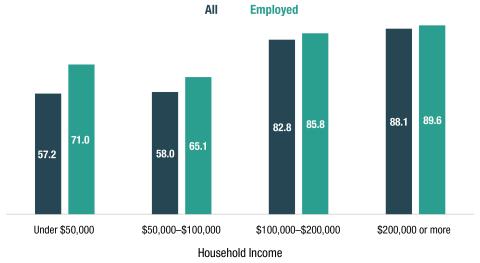Key Findings

Data from the U.S. Census Bureau collected between January and May 2023 show that access to child care remains uneven. Among New England households with a child under age five, 71.1 percent had used at least some child care, paid or unpaid, in the past seven days. However, use varied with income: 88.1 percent of households with young children and incomes over $200,000 used child care, compared with 57.2 percent of those with incomes under $50,000 (Figure 1). Although low-income households where the survey respondent is employed more often used child care than low-income households overall, employment status does not fully close the income gap in use. That is, lower-income working households are 18.6 percentage points less likely to use care than their higher-income counterparts. These findings suggest that in low-income New England households, access to early care opportunities—as a learning environment for kids and a work support for parents—is falling short.

Note: Estimates are calculated using household-level replicate weights. Child care use includes both paid and unpaid nonparental care, including child care center, relative, non-relative, home-based provider, or a combination of any. Source: U.S. Census Bureau, Household Pulse Survey, Phases 3.7–3.8 (partial), Weeks 53–57.
About the Author

Jess Carson is the director of the Center for Social Policy in Practice and a research assistant professor at the University of New Hampshire’s Carsey School of Public Policy.
